All the solutions provided in McGraw Hill My Math Grade 5 Answer Key PDF Chapter 12 Lesson 4 Sides and Angles of Quadrilaterals will give you a clear idea of the concepts.
McGraw-Hill My Math Grade 5 Answer Key Chapter 12 Lesson 4 Sides and Angles of Quadrilaterals
A quadrilateral is a polygon with four sides and four angles.
Measure It
Measure the sides and angles of each figure to determine if any are congruent. Then determine if any sides are parallel. Complete the table.

Each figure has ____________ sides and ____________ angles.
Answer:
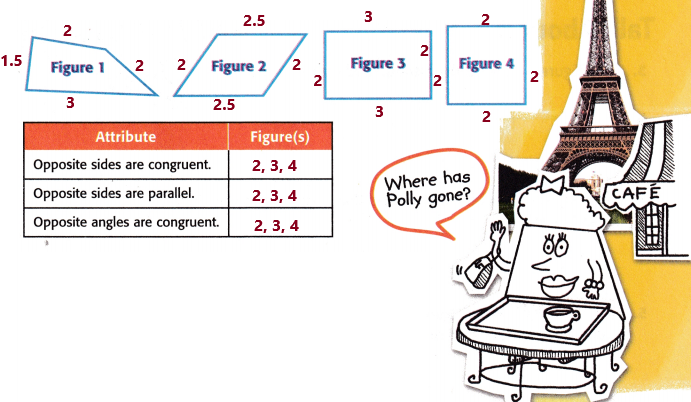
Each figure has 4 sides and 4 angles.
Talk About It
Question 1.
What common attributes do all of the figures have?
Answer:
The common attributes of all the above-given figures are their sides and angles.
Question 2.
Does Figure 3 have all the attributes of Figure 2? Explain.
Answer: yes.
It has opposites sides that are parallel, congruent, and angle.
– A rectangle is also a parallelogram because it satisfies the conditions or meets the properties of a parallelogram such as the opposite sides being parallel and diagonals bisect each other.
Try It
Measure the sides and angles of each figure to determine if any are congruent. Then determine if any sides are parallel. Complete the table.

Answer:
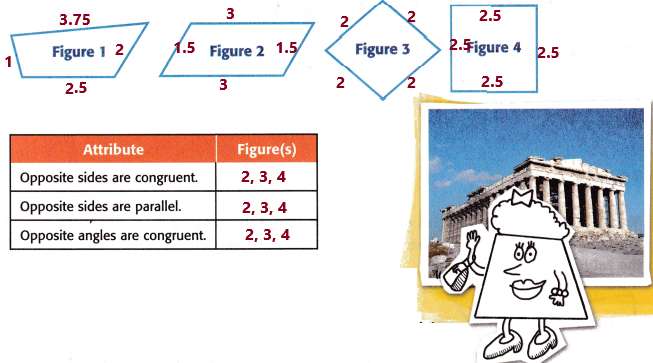
Talk About It
Question 3.
Does Figure 3 have all the attributes of Figure 2? Explain.
Answer: yes
figure 3 has opposite sides that are congruent and parallel. And opposite angles are also congruent.
A rhombus is a special case of a parallelogram. In a rhombus, opposite sides are parallel and the opposite angles are equal. Moreover, all the sides of a rhombus are equal in length, and the diagonals bisect each other at right angles. The rhombus is also called a diamond or rhombus diamond.
Question 4.
What are some additional attributes that Figure 4 has that Figure 3 doesn’t have?
Answer:
They do not have any right angles.
Question 5.
Mathematical PRACTICE Make Sense of Problems Explain how Figure 2 is a special kind of polygon.
Answer:
A parallelogram is a special kind of polygon because it has equal angles and equal sides.
It is a closed figure with four line segments that do not cross. Moreover, both pairs of opposite sides are parallel and congruent.
Question 6.
Which figure does not have any of the attributes listed in the table?
Answer: Figure 1.
Because the figure has no congruent sides and no congruent angles. At least opposite sides and angles are also not congruent.
Practice It
Measure the sides and angles of each figure to determine if any are congruent or parallel. Then answer Exercises 7-13.
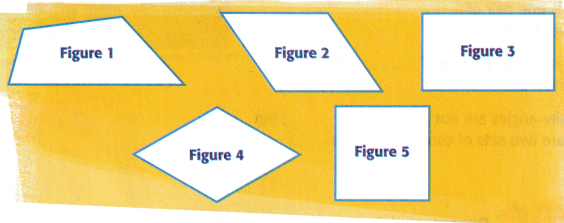
Question 7.
Complete the attributes of Figure 1.
Opposite sides are _____________ and _____________.
Opposite angles are ______________.
The figure has _____________ sides and ______________ angles.
Answer:
figure 1: 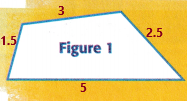
Opposite sides are not parallel and not congruent.
Opposite angles are not congruent.
The figure has 4 sides and 4 angles.
Question 8.
Complete the attributes of Figure 2.
Opposite sides are _____________ and _____________.
Opposite angles are ______________.
The figure has _____________ sides and ______________ angles.
Answer:
Figure 2:

Opposite sides are parallel and congruent
Opposite angles are equal
The figure has 4 sides and 4 angles.
Question 9.
Which figures have all the attributes of Figure 1?
Answer:
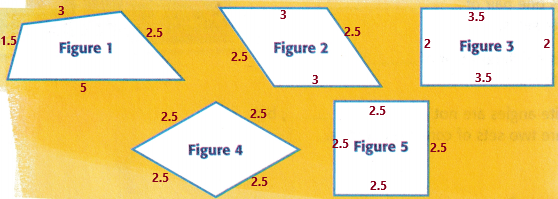
Compare all the figures with their attributes
Except for figure 1 all the figures have some common attributes.
Comparing figure 1 with all the figures there are no attributes that are common.
Therefore, none of the figures has all the attributes of figure 1.
Question 10.
Which figures have all the attributes of Figure 2?
Answer: 3, 4, 5
Because they have opposite sides that are parallel and congruent, opposite angles are congruent.
Question 11.
Which figures have all the attributes of Figure 3?
Answer: 5
– A rectangle is a square when both pairs of opposite sides are the same length. This means that a square is a specialized case of the rectangle and is indeed a rectangle.
– A square is also called a special rectangle because it possesses some properties of rectangles and fits the definition of the rectangle, like interior angles being 90 degrees, opposite sides being equal and parallel, and the diagonals bisect each other. But the square has two additional features which make it a special rectangle: all four sides are equal and the diagonals bisect each other at 90 degrees.
Question 12.
Which figures have four right angles?
Answer: 3, 5
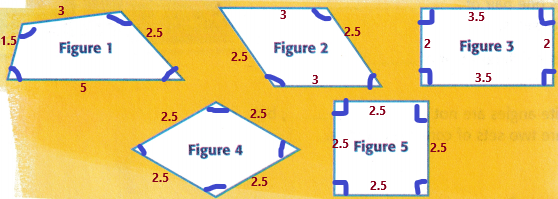
Squares and rectangles have a right angle.
Question 13.
Which figures have four equal sides?
Answer: 4, 5
square and rhombus are having equal sides.
Apply It
Question 14.
Complete the attributes of the red quadrilateral outlining one side of the Chichen Itza pyramid in Mexico.
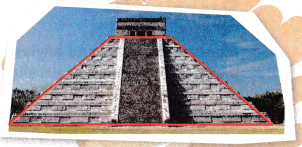
There is one pair of ______________ opposite sides.
There is a different pair of ______________ opposite sides.
Opposite angles are not ____________, but there are two sets of congruent angles.
Answer:

There is one pair of parallel opposite sides.
There is a different pair of congruent opposite sides.
Opposite angles are not congruent but there are two sets of congruent angles.
Question 15.
Mathematical PRACTICE Reason Explain one way to determine if a quadrilateral has parallel sides.
Answer:
– We can measure the distance between the opposite sides to determine if they are the same distance apart.
Question 16.
Mathematical PRACTICE Which One Doesn’t Belong? Circle the quadrilateral that does not belong with the other three. Explain your reasoning.

Answer:

The remaining 3 have 1 pair of parallel sides.
Write About It
Question 17.
How are all quadrilaterals alike and how can they be different?
Answer:
– The corresponding angles are equal/congruent. (Both interior and exterior angles are the same)
– The ratio of the corresponding sides is the same for all sides. Hence, the perimeters are different.
– All quadrilaterals have sides of different lengths and angles of different measures.
McGraw Hill My Math Grade 5 Chapter 12 Lesson 4 My Homework Answer Key
Practice
Refer to the figures above in the Homework Helper to solve Exercises 1-3.
Question 1.
Complete the attributes of Figure 2.
Opposite sides are ______________ and ______________.
Opposite angles are ______________.
The figure has ______________ sides and ______________ angles.
Answer:
Figure 2 is a parallelogram
A parallelogram is defined as a quadrilateral in which both pairs of opposite sides are parallel and equal.
From the above definition, we can say that:
opposite sides are parallel and congruent.
Opposite angles are congruent.
The figure has 4 sides and 4 angles.
Question 2.
Which figures have all the attributes of Figure 2?
Answer: 3, 4, 5
Figure 3 is a rectangle.
Figure 4 is a rhombus.
Figure 5 is a square.
A parallelogram is a special kind of quadrilateral that is formed by parallel lines. The angle between the adjacent sides of a parallelogram may vary but the opposite sides need to be parallel for it to be a parallelogram. A quadrilateral will be a parallelogram if its opposite sides are parallel and congruent. Hence, a parallelogram is defined as a quadrilateral in which both pairs of opposite sides are parallel and equal. Observe the following figure which shows the three types of parallelograms:
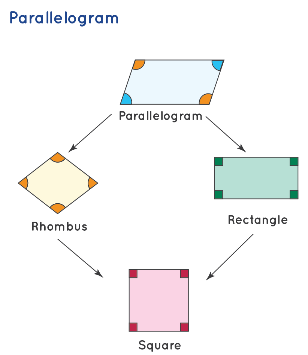
Question 3.
Which figures have four right angles?
Answer:
Figure 3 and figure 5
Figure 3 is a rectangle
Figure 5 is a square.
The right angles are shown in the below diagram:
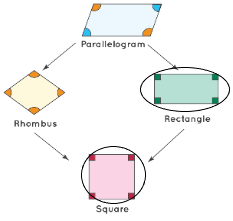
Problem Solving
Question 4.
The state of Nevada is in the shape of a quadrilateral. Complete the attributes of the outline of the state of Nevada.

There is one set of ______________ opposite sides.
Opposite sides are not ______________.
Opposite angles are not ______________, but there are two right angles.
Answer:
It is the shape of the quadrilateral.
There are 4 sides and 4 angles.
There is one set of parallel opposite sides.
Opposite sides are not congruent.
Opposite angles are not congruent, but there are two right angles.
Question 5.
Mathematical PRACTICE Reason Explain one way to determine if a quadrilateral has congruent angles.
Answer:
The easiest, simplest way to determine if a quadrilateral has a congruent angle is to pull out a protractor and measure the angles.
Question 6.
Mathematical PRACTICE Which One Doesn’t Belong? Circle the quadrilateral that does not belong with the other three. Explain your reasoning.

Answer:

The circled one has one pair of opposite sides.
The remaining three has two pair of opposite sides.
Vocabulary Check
Fill in each blank with the correct term or number to complete the sentence.
Question 7.
A quadrilateral is a polygon with ______________ sides and ______________ angles.
Answer:
A quadrilateral is a polygon with 4 sides and 4 angles.
A quadrilateral is a closed shape and a type of polygon that has four sides, four vertices and four angles. It is formed by joining four non-collinear points. The sum of the interior angles of quadrilaterals is always equal to 360 degrees.